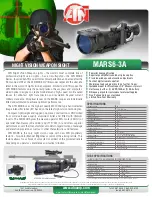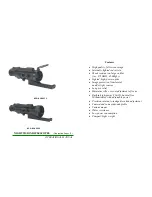
7
2. Loosen the latitude locking T-bolt. Turn the latitude adjust-
ing T-bolt and tilt the mount until the pointer on the lati-
tude scale is set at the latitude of your observing site. If
you don’t know your latitude, consult a geographical atlas
to find it. For example, if your latitude is 35° North, set the
pointer to +35. Then retighten the latitude locking T-bolt.
The latitude setting should not have to be adjusted again
unless you move to a different viewing location some dis-
tance away.
3. Loosen the Dec. lock knob and rotate the telescope opti-
cal tube until it is parallel with the R.A. axis. The pointer
on the Dec. setting circle should read 90°. Retighten the
Dec. lock knob.
4. Loosen the azimuth lock knob and rotate the entire equa-
torial mount left-to-right so the telescope tube (and R.A.
axis) points roughly at Polaris. If you cannot see Polaris
directly from your observing site, consult a compass and
rotate the equatorial mount so the telescope points
North. Retighten the azimuth lock knob.
The equatorial mount is now approximately polar-aligned for
casual observing. More precise polar alignment is required
for astrophotography. Several methods exist and are
described in many amateur astronomy reference books and
astronomy magazines.
Note: From this point on in your observing session, you
should not make any further adjustments in the azimuth
or the latitude of the mount, nor should you move the
tripod. Doing so will undo the polar alignment. The tele-
scope should be moved only about its R.A. and Dec.
axes.
Use of the R.A. and Dec.
Slow-Motion Control Cables
The R.A. and Dec. slow-motion control cables allow fine
adjustment of the telescope’s position to center objects with-
in the field of view. Before you can use the cables, you must
manually “slew” the mount to point the telescope in the vicini-
ty of the desired target. Do this by loosening the R.A. and
Dec. lock knobs and moving the telescope about the mount’s
R.A. and Dec. axes. Once the telescope is pointed some-
where close to the object to be viewed, retighten the mount’s
R.A. and Dec. lock knobs.
The object should now be visible somewhere in the tele-
scope’s finder scope. If it isn’t, use the slow-motion controls
to scan the surrounding area of sky. When the object is visi-
ble in the finder scope, use the slow-motion controls to cen-
ter it. Now, look in the telescope with a long focal length (low
magnification) eyepiece. If the finder scope is properly
aligned, the object should be visible somewhere in the field
of view.
Once the object is visible in the telescope’s eyepiece, use
the slow-motion controls to center it in the field of view. You
can now switch to a higher magnification eyepiece, if you
Figure 4.
The equatorial mount.
R.A. lock knob
R
RII
G
G
H
HT
T
A
AS
SC
CE
EN
NS
SII
O
O
N
N
A
AX
XII
S
S
Declination (Dec.)
slow motion control
Latitude adjustment T-bolt
Azimuth lock knob
Declination (Dec.)
setting circle
Right ascension
(R.A.) setting circle
Right ascension (R.A.)
slow motion control
Latitude locking T-bolt
Latitude scale
D
E
C
L
IN
A
T
IO
N
A
X
IS
Figure 5.
To find Polaris in the night sky, look north and find the
Big Dipper. Extend an imaginary line from the two “Pointer Stars” in
the bowl of the Big Dipper. Go about five times the distance
between those stars and you’ll reach Polaris, which lies within 1° of
the north celestial pole (NCP).
Big Dipper
(in Ursa Major)
Little Dipper
(in Ursa Minor)
N.C.P.
Point
er St
ars
Cassiopeia
Polaris


















